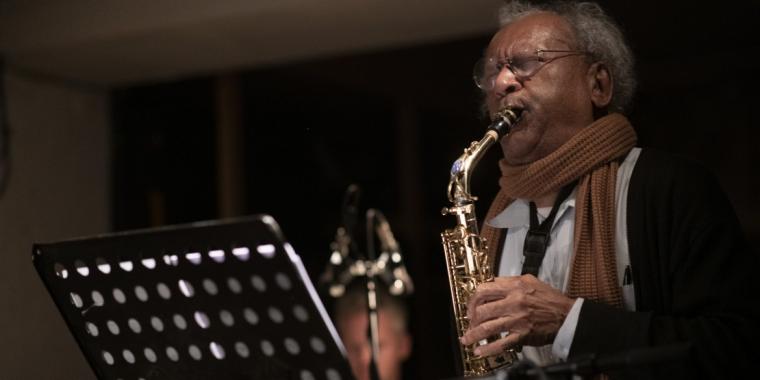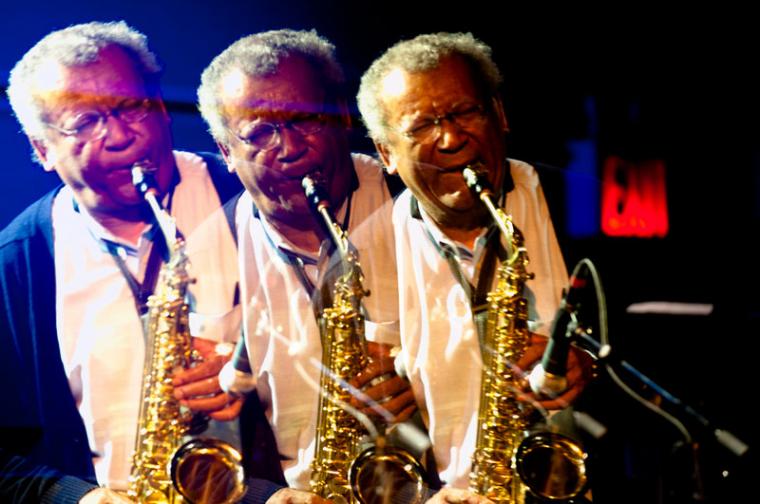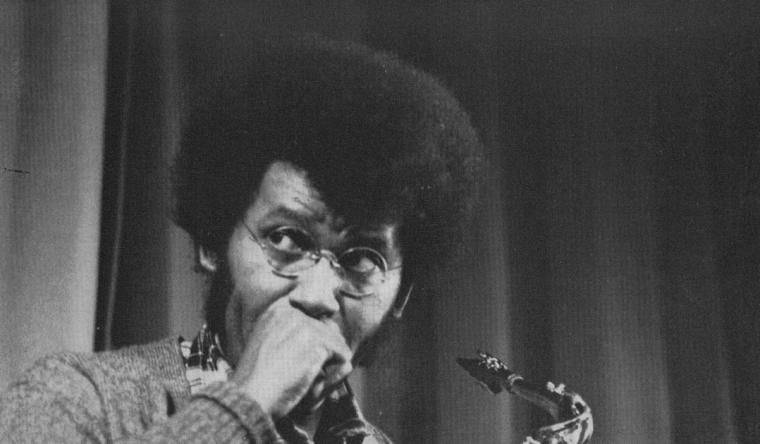
Anthony Braxton
On June 4, the iconoclastic composer, esteemed academic/pedagogical luminary, and free-jazz firebrand Anthony Braxton turned 75 years old. To trace the course of Braxton’s career, from its beginnings in the late-1960s with groundbreaking works such as 3 Compositions of New Jazz and the double-LP solo sax masterpiece For Alto, across over 100 recordings of his live horn/woodwind performances, small group jazz-orbiting sessions, and exhibitions of his compositions for all manner of large ensembles, is to witness far-flung threads of the 20th century avant-garde tradition improbably lace together into one fully synthesized oeuvre with virtually no touchstones for comparison. Braxton’s work long ago shattered the divide between the gritty, atonal language of improvised free jazz performance and the typically cloistered world of academic classical and minimalist composition, and he continues to expand in unexpected directions with new works that emerge to this day.
Braxton singlehandedly pioneered the idiom of solo saxophone performance, proving that one person could transfix listeners in the context of an unaccompanied performance of one horn and one microphone. His branchings into orchestral compositions and pieces for atypical ensembles (e.g., 100 tubas, electronic-processed choir) draw a through-line from the foundation of Stravinsky, Stockhausen, and Varèse to the catalogs of Ornette Coleman and Pharaoh Sanders to the drone-focused works of minimalist composers Morton Feldman and Phill Niblock. One would be hard-pressed to find another artist who has been commissioned by modernist classical organizations around the world to compose full-length operas and works for orchestra, and who has also performed live in concert with American noise icons Wolf Eyes (at a festival in Victoriaville, Quebec that was captured on an album titled Black Vomit). Needless to say, Braxton’s vision knows no boundaries of genre and actively defies convention at every turn, all while he sketches out new trajectories for those who follow in his wake to experiment without inhibition.
On the occasion of his 75th birthday, the organization The Tri-Centric Foundation, which is dedicated to the preservation, cataloging, and continued performance of his music, uploaded a treasure trove of Anthony Braxton’s recordings onto Bandcamp – under the heading “New Braxton House.” Meant to centralize his work into one location where curious listeners can sink in, the (incomplete) catalog here encompasses 62 releases from all eras of his career and all manner of ensembles for which he has composed. To excise any limited selection of releases from this canon would be to highlight only a tiny fraction of the diverse work that he has put into this world, but that will not stop me from doing so.
1) Solo (Kent) 1979
https://newbraxtonhouse.bandcamp.com/album/solo-kent-1979
Among the chronologically earliest releases in the New Braxton House catalog on Bandcamp, Solo (Kent) 1979 captures a live performance at Kent University with Braxton on solo alto saxophone – channeling the same recording practice that led to his groundbreaking 1969 album For Alto. Braxton’s solo horn performances contain the seed from which his entire recorded catalog springs, as they define his approach to (a)tonality and improvisation, his acute sense of musical structuring and narrative flow, and his ever-present exploration of the transportive effects of controlled chaos. “Composition No. 77 A,” which kicks off this set, could serve as a manifesto for the solo-horn sector of his catalog. Showcasing his virtuosic control of breath and his lightning fingering, Braxton winds his way through a torrent of juxtaposed sax phrases that range from pure noise skronk, to moments of legible harmony, to textural techniques designed to push the saxophone to its physical brink. The tones he produces in solo performance can rise to the absolute top of the instrument’s range, emerging in piercing whistle tones like a bird gasping for air, or pour out in a cascade of gnarled, chromatic phrases a few steps removed from John Coltrane’s “sheets of sound” performance style. The close mic-ed performance here captures Braxton’s every breath, every press upon the sax’s key buttons, and every gasp from the crowd. The next piece, “What’s New,” finds Braxton pushing the sheer output of notes emitted past the limits of sanity, while threading moments of lyricism and major-key melody into the din – a move that evokes the work of free jazz icons such as Albert Ayler, for whom the fanfares of the marching band and the military horn ensemble were always laced into the context of uninhibited, atonal sax improvisation.
2) Trio (Wesleyan) 2005
https://newbraxtonhouse.bandcamp.com/album/trio-wesleyan-2005
Recorded at Wesleyan University in Middletown, Connecticut, Braxton’s long-time home base and the institution where he taught music composition and music history for more than 20 years, Trio (Wesleyan) 2005 showcases a trio performance of Braxton, omnivorous brass player Taylor Ho Bynum, and guitarist Tom Crean. The album exemplifies a subsection of Braxton’s output that he named Diamond Curtain Wall Music, which combines the raw output of an ensemble of players improvising in the uninhibited free-jazz idiom with an interactive backdrop of electronics that respond to their playing in real time. The data- and code-based computer music program SuperCollider provides the electronic accompaniment here, producing synthetic tones and patches of disfigured electronic noise that emerge from the system and swell along with whatever the musicians pour out of their instruments. In typical Braxton fashion, the tonal palette on display here is continually alien and baffling, while maintaining some semblance of what could be considered a “traditional” jazz ensemble. The various brass instruments that Braxton and Bynum weaponize in this session sound like wailing sirens, grunting animals, and melting trumpet calls that ring out like “Taps” played to wake a platoon of demons at sunrise. Crean provides a perfect counterpoint to the brass chaos with his electric- and acoustic-guitar improv, which ranges from stuttering finger-picked atonality, to warp-speed electric guitar shred, to the sound of fingers scraping against the fretboard. All the while, Braxton’s SuperCollider system forms the fourth member of the ensemble, blasting out walls of electronic noise into the open air, or dipping down into barely-there textures that sound like whispered field recordings in moments of near silence.
3) Octet (New York) 1995
https://newbraxtonhouse.bandcamp.com/album/octet-new-york-1995
An example of the style of composition and performance that Braxton titled Ghost Trance, Octet (New York) 1995 showcases an unbroken composition that stretches to almost an hour in length. The eight-person ensemble includes a horn section (featuring Braxton himself), vibraphone and percussion, upright bass, accordion, violin, and more, with many performers actively switching between instruments on the fly when the need arises. Braxton’s Ghost Trance idiom essentially boils down to the playing of a winding, staccato melody that the ensemble keeps going at various tempos and levels of intensity for the whole duration of the piece. At times, this centerpiece melody can sound like a Stravinsky-esque modernist ensemble blurting out an atonal stream of notes, like a symphony orchestra unplugged from conventions of harmony and allowed to simply wail – but always tethered closely together in terms of synchronized rhythms and tempos. While the bulk of the ensemble keeps this melody pumping out, Braxton encourages soloists from the group to leap into action at moments, tempering that winding, central melody with bursts of fiery sax screaming, spiraling accordion phrases, or clattering instances of chimed vibraphone. Braxton described this structure as a unified center with a series of “exits,” both notated and un-notated, that performers could leap into to break from the main theme. In the constant war of attrition between conventional rhythm and unhinged madness, someone in the ensemble is always sticking to the central melody at any given moment, as if to remind us of the piece’s roots in the modernist European classical tradition. But Braxton ensures that the piece nods to that tradition simply as a point to start at and then to continually pervert and shatter. Shards of free jazz and pure atonality leap from the ensemble as they streak down the highway, looking back at the European canon receding behind them in the rear-view mirror.

4) Syntactical GTM Choir (NYC) 2011
https://newbraxtonhouse.bandcamp.com/album/syntactical-gtm-choir-nyc-2011
Another recording under the umbrella of Braxton’s Ghost Trance works, this release showcases a live performance of 13 vocalists at the venerable New York City avant-garde venue Roulette in 2011. If you’re wandering into Braxton’s catalog for the first time, his unbelievable command of the language of choral music might come as a surprise. How can this one man have pioneered solo saxophone performance, compose works for orchestra, play in gnarly small jazz ensembles, and compose punishingly complex works for the human voice? By now, you should understand that Braxton can do anything. The Syntactical Ghost Trance Music Choir works their way through Braxton’s hyper-dense libretto here, latching into phrases that sound like the human voice box melting down the scale or leaping up into harsh climaxes of headache-inducing brutality. Discrete words emerge from the mire of voices, often in the form of numbers and mathematical figures (“twenty-six plus thirty-four”), further exemplifying Braxton’s long-standing incorporation of elements from math and other formal, quantitative realms of study into the context of free-wheeling modern composition. The choir bops their way through wordless synchronized melodies that sound like jazz vocal scatting at its most deconstructed, or launches together into full-throated screams. Certain vocalists take center stage as soloists whose mutant melodies channel the fury of Braxton’s sax performance, but all pumped from a larynx instead of the bell of a horn. The sheer range of extended vocal techniques on display here, from amplified vocal fry and whispering to operatic falsetto peaks, defies all reason.
5) Composition No. 19 (For 100 Tubas)
https://newbraxtonhouse.bandcamp.com/album/composition-no-19-for-100-tubas
Yes, that’s right: one hundred tubas. Braxton wrote this piece in the early 1970s, and the performance documented here took place at the World Financial Center in New York City's Battery City Park in 2006. Divided into four groups of 25 tubaists that are each overseen by a conductor (including Braxton himself and longtime collaborator Taylor Ho Bynum), the ensemble here must have taken up a fair bit of space in the physical world, to say the least. On the more minimal side of the full spectrum of Braxton’s catalog, Composition No. 19 rumbles across swathes of unbroken low end as it slowly burns its way through a score focused on overlapping swells and rubato mid-range phrases. The piece’s drama stems from the tension between the formless mass of bass tuba drone and the moments in which small groups of tubas lock together into quasi-melodies, which often hit like peaks of sudden occult energy that you might find in the score to a horror movie. The two halves of the composition both stretch past the 20-minute mark, and though they occasionally settle into periods of near stasis, Braxton keeps the narrative continually moving forward. The first piece culminates in a climax of interlaced tuba blasts that possesses a level of firepower that could only be realized with, well… . So. Many. Tubas. The second half of the piece, in typical Braxton fashion, maintains a bedrock of droning tuba output but allows certain players to stretch out and “exit” that framework as they start spiraling off into torrents of free-jazz anti-melody. At other moments, Braxton switches up the textural palette on display, encouraging certain tubaists to manically blow air into their instruments or scrape their fingers across the buttons, which introduces sinister wind-like and percussive elements into the already pitch-black haze. The last four minutes or so of the piece have to be heard to be believed, as those aforementioned peals of what seemed to be improvised tuba skronk prove to be tightly notated, to the point that many tubas at once lock in to pump out the same atonal phrases together.
6) Duo (Improv) 2017 – Anthony Braxton and Eugene Chadbourne
https://newbraxtonhouse.bandcamp.com/album/duo-improv-2017
A meeting of two iconoclasts and friends for many decades, this album finds Braxton linking up with legendary genre-obliterating guitarist and string player Eugene Chadbourne for roughly eight hours of duo improvisation, with Braxton on sax and Chadbourne on various guitars and banjos. Operating somewhere in the wide territory of Appalachian folk guitar, American Primitive performance (à la John Fahey), and mutated, “rock”-adjacent free improv, Chadbourne was, according to legend, persuaded by Braxton to seriously pursue music when he was on the cusp of switching his main focus from music to journalism in the 1970s. The telepathic interplay between Braxton and Chadbourne in these sessions is nothing short of spellbinding, illustrating the depths to which both artists have explored in the style of free improv, and the language they so easily latch into when put in the same room together. Though there are plenty of moments in which the two of them roar into full assault mode, deluging us with continual streams of notes meant to overwhelm our senses, the most common baseline they occupy here is one of open space and careful listening to each other. Braxton deftly switches between barked, guttural phrases on the low end of the sax’s range to his typically raucous, squealed upper register. Chadbourne demonstrates his comfort on the guitar in virtually any tonality or rhythmic framework as he shifts between steadily chugging, finger-picked phrases that sound like corrupted back-porch folk music, to squalls of fast fretwork that fall off the deep end into sheer mania. Chadbourne essentially plays the wild-card here as he switches from instrument to instrument, cycling from the acoustic twang of the banjo to the long, throbbing sustain of the baritone electric guitar, to the textural scrape of the prepared guitar with its frets loaded with bits of metal and wood. This opens up a fascinating context in which Braxton plays the role of the straighter, more regimented player in the duo, “limited” to the vocabulary of solo sax performance – though of course, in Braxton’s hands, the solo saxophone contains an entire universe.











